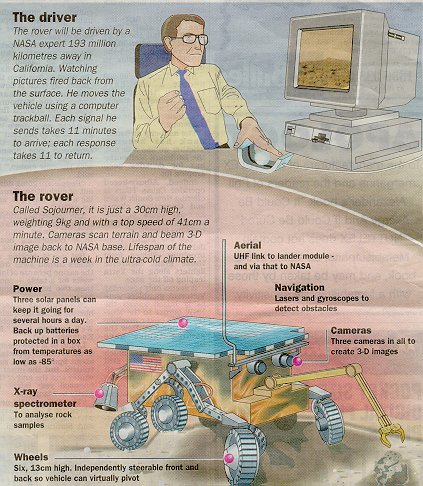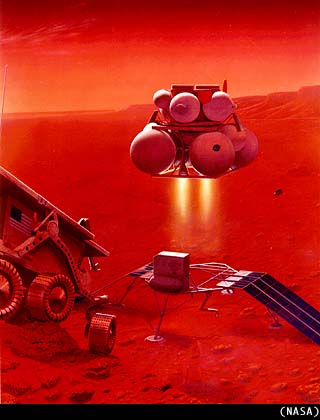 The Mars Pathfinder is an amazing machine. There are two parts to the Pathfinder. The first part is the spacecraft. The basic design of the Mars Pathfinder spacecraft involves an aero-shell , parachute, rockets, an air bay entry system and a landing system. It also carries heater units that are vital in the sub zero temperatures. The spacecraft uses a R6000 computer with a VME bus. This system is considerably powerful, executing anywhere from 2.5 to 20 million instructions per second (MIPS) The mass memory of this computer can hold is 128 million bytes. This incredible computer sends back photos of the Mars landscape revealing whether conditions might be suitable for life - or life in the past. For propulsion, the spacecraft carries eight 4.4 Newton thrusters.
The Mars Pathfinder is an amazing machine. There are two parts to the Pathfinder. The first part is the spacecraft. The basic design of the Mars Pathfinder spacecraft involves an aero-shell , parachute, rockets, an air bay entry system and a landing system. It also carries heater units that are vital in the sub zero temperatures. The spacecraft uses a R6000 computer with a VME bus. This system is considerably powerful, executing anywhere from 2.5 to 20 million instructions per second (MIPS) The mass memory of this computer can hold is 128 million bytes. This incredible computer sends back photos of the Mars landscape revealing whether conditions might be suitable for life - or life in the past. For propulsion, the spacecraft carries eight 4.4 Newton thrusters.
The second part of the Mars Pathfinder is the Sojourner, also know as the Rover which is about the size of a microwave oven. The Rover, (It's official name is Micro-rover Flight Experiment) weighs less than 14 kilograms (31 lbs.) which includes it mounting and deployment equipment. It's mobile mass is only 11.5 kilograms (25 lbs.) which does include the Alpha Proton X-ray. The Rover is powered by 25 square centimeters (0.25 square meters) of solar panels, which produces a peak power of 16-watt hours. Its primary battery provides 150-watt hours. This power also has to power three heater units, which are necessary for temperature control. The Rover can move approximately 41 centimeters a minute. The design feature that makes the Mars Pathfinder Rover perfect to move freely on the Martian landscape is the six 13cm high wheels. Each wheel is independently controlled. A NASA expert navigates the Mars Pathfinder Rover. Each signal sent out to the Rover takes 11 minutes, so does the signal to get back to Earth, sent from the Rover. The Rover's wheels can be used to get valuable information about the properties of the Mars dust, by scraping molding and stirring it up.
 The major scientific goals of this mission were:
The major scientific goals of this mission were:
- Mapping the terrain and morphology of the landing site.
- Determine the mineral in the rocks, soil and dust at the landing site.
- Observe the weather at the landing site including wind velocity and direction, frost and cloud information.
- Observe the atmosphere including measuring the amount of water in it.
- Study the magnetic properties of the dust.
- Study Mars at night, including the study of the moon, Phobos and Deimos.
Distribution of rocks/composition of local rock and how it compares to Earth:
The images showed a series of 4 meter high ridges and valleys near the landing site which the scientist think were carved by a great water deluge. The landing site surface had a reddish hue, and five whitish rocks were found which was of a great interest because it implied that its material was repeatedly heated, cooled and reheated to form a quality like material. The rock named "Barnacle Bill" appeared to be volcanic in origin and resembled rocks on earth - something that was unexpected.
Evidence of Water existing on Mars:
Evidence of dried up channels and puddles also suggested that Mars was warm enough for a time to keep its water from freezing. There is evidence of many floodings on Mars as the area included many "Round rocks transported by water." Water ice clouds are found around the planet as well as ice in the Polar Regions. There is great evidence to show the role water has played in the erosion of the landing sitee and the formation of iron oxides
Weather, Temperature and Air Pressure:
With days of about 24 hours, at least 2 and perhaps 4 seasons, lots of carbon and a thin cold carbon dioxide atmosphere shows that Mars is not too different from Earth. The Pathfinders weather station recorded unexpected, huge swings of as which as 40°F (about 6 - 7°C) within seconds or minutes of each other. At midday the sensor recorded temperatures of about 70°F at ground level, but a chilly 10 - 15°C just 5 feet about the same spot. Temperatures also change dramatically between days and night: -120°C to -15°C is not uncommon swings of temperature. There are spectacular sunrises and sunsets - the dust mixing with the atmosphere to give the sky its red colouring. The winds show to be mild with the occasional 200 kmp/h wind gust - mostly from the west.
How much dust is in the atmosphere:
The Rover's wheels can be used to get valuable information about the properties of the Mars dust by scraping, molding and stirring it up. There is a great deal of dust in the atmosphere - the sky stays bright for 2 hours after sunset indication the dust extends to high altitudes. The cameras aboard the Rover use stereoscopic glasses and different colour blocking flitters and shows much about the landscape, dust and atmosphere because the blocked colours can represent different chemicals. Scientist now need to study the analysis of the exact composition of the dust particles.
Final Thoughts:
What an exciting time for space exploration. During the next decade Mars will be the most popular travel destination. Pathfinder is only the 1st of many missions by USA, Russia and Japan. NASA has plans to launch crafts during every available "Launch Windows" between now and 2005
<-- Previous Page --- Next Page -->
|
|
|
|
- Main
- Contact
- Comptech Webring
- Guestbook
- Site Tour
- CL-Help
|
Space Poll
|
What event will next be achieved?
|
|


 Back_
Back_ Top_
Top_